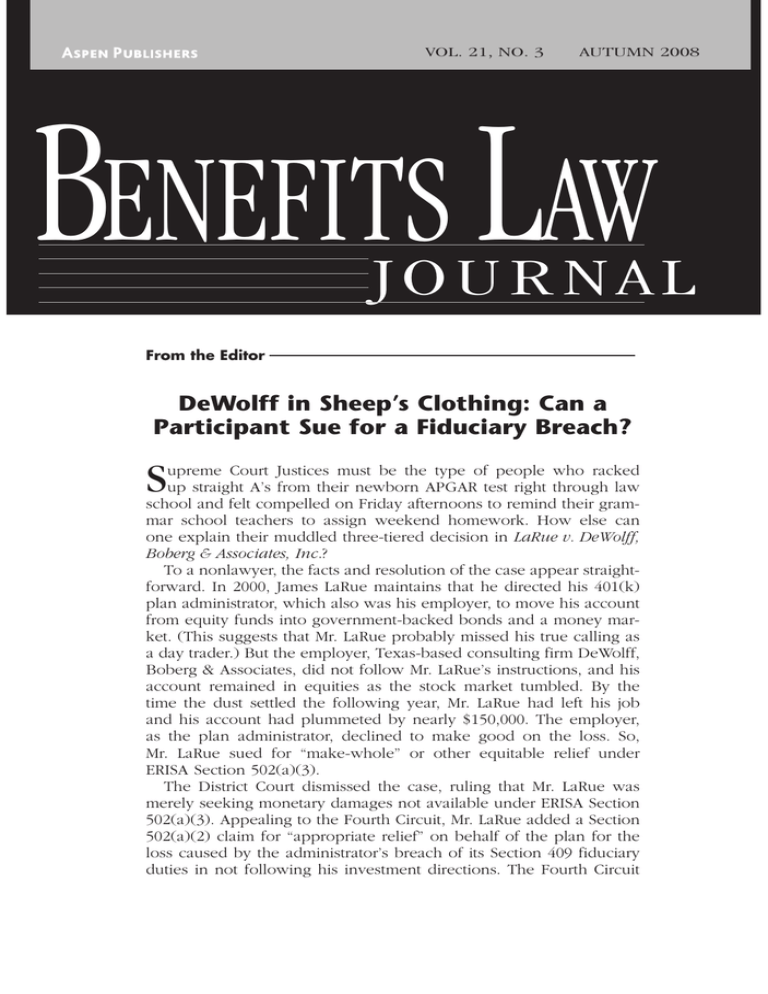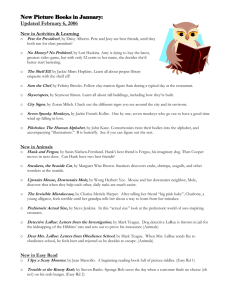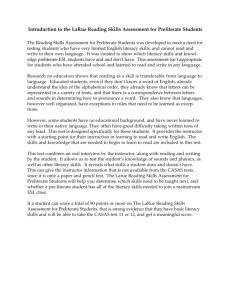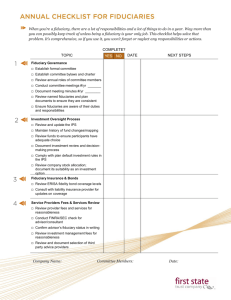B L ENEFITS AW
advertisement

VOL. 21, NO. 3 AUTUMN 2008 BENEFITS LAW JOURNAL From the Editor DeWolff in Sheep’s Clothing: Can a Participant Sue for a Fiduciary Breach? S upreme Court Justices must be the type of people who racked up straight A’s from their newborn APGAR test right through law school and felt compelled on Friday afternoons to remind their grammar school teachers to assign weekend homework. How else can one explain their muddled three-tiered decision in LaRue v. DeWolff, Boberg & Associates, Inc.? To a nonlawyer, the facts and resolution of the case appear straightforward. In 2000, James LaRue maintains that he directed his 401(k) plan administrator, which also was his employer, to move his account from equity funds into government-backed bonds and a money market. (This suggests that Mr. LaRue probably missed his true calling as a day trader.) But the employer, Texas-based consulting firm DeWolff, Boberg & Associates, did not follow Mr. LaRue’s instructions, and his account remained in equities as the stock market tumbled. By the time the dust settled the following year, Mr. LaRue had left his job and his account had plummeted by nearly $150,000. The employer, as the plan administrator, declined to make good on the loss. So, Mr. LaRue sued for “make-whole” or other equitable relief under ERISA Section 502(a)(3). The District Court dismissed the case, ruling that Mr. LaRue was merely seeking monetary damages not available under ERISA Section 502(a)(3). Appealing to the Fourth Circuit, Mr. LaRue added a Section 502(a)(2) claim for “appropriate relief” on behalf of the plan for the loss caused by the administrator’s breach of its Section 409 fiduciary duties in not following his investment directions. The Fourth Circuit From the Editor had no problem concluding that Mr. LaRue could not reconfigure his request for the $150,000 in lost value as equitable relief under Section 502(a)(3). To determine whether Mr. LaRue could sue under ERISA Section 502(a)(2) for the employer-fiduciary’s breach of duty, the Fourth Circuit turned for guidance to the Supreme Court’s 1985 decision in Massachusetts Mutual v. Russell. In Russell, which involved a disability plan participant seeking damages for delayed benefit payment, the Supreme Court held that Section 502(a)(2) “provides remedies only for the entire plans, not for individuals.” Based on Russell, the Fourth Circuit determined that Mr. LaRue only was making an individual claim on behalf of himself and was, therefore, out of luck. If we stop the tape right here and take Mr. LaRue at his word, common sense and fair play would seem to dictate that he be able to recover his loss. After all, Mr. LaRue followed the plan rules in exercising his right to switch investments. His loss was clearly caused solely by the plan administrator’s error. While the fiduciary did not in any way benefit from the transaction, it did cause Mr. LaRue real injury—something akin to “fiduciary malpractice.” The difficulty comes in figuring out in which ERISA-relief box to fit Mr. LaRue’s claim. And this is exactly where the Supreme Court got lost. (Incidentally, a peek at the transcript of oral argument finds the Court seemingly befuddled by mutual fund investing and self-directed 401(k) plans and perhaps wishing that ERISA would, somehow, just go away.) All nine Justices accepted that Mr. LaRue was an innocent bystander entitled to his day in court, and they remanded the case for further proceedings. They also seemed unanimous in recognizing that Mr. LaRue had no chance of winning on his Section 502(a)(3) claim for equitable relief, as the $150,000 he was seeking was classic monetary damages. But once the Court got specific and focused on Mr. LaRue’s argument that he should be able to recover under Section 502(a)(2) for the fiduciary’s breach, the Justices not only failed to agree on why they were remanding the case, but did not even provide the lower court with instructions on how to proceed. First, the majority opinion written by Justice Stevens informed the Fourth Circuit (and just about everybody else in the ERISA world) that they’d in fact misread the Russell decision. As a fiduciary, the Court noted, the plan administrator had a duty to manage the assets of the 401(k) plan with care. (Okay so far.) In the “old days,” most plans were defined benefit plans in which all participants ate out of the same pension pot. Russell’s “emphasis on protecting the ‘entire plan’ from fiduciary misconduct reflects the former landscape of employee benefit plans.” (Under this rationale, would Mr. LaRue have lost his case in 1982 because 401(k) plans were hardly known?) Now that BENEFITS LAW JOURNAL 2 VOL. 21, NO. 3, AUTUMN 2008 From the Editor 401(k) plans are generally replacing pension plans, the Court noted that it matters less whether the fiduciary caused a loss to the entire plan, or just one participant’s individual account. Meandering back toward the ruling in Russell, the majority held that, although Section 502(a)(2) does not “provide a remedy for individual injuries…[it] does authorize recovery for fiduciary breaches that impair…a participant’s individual account.” (By definition, under Russell, isn’t a loss solely to one person an individual injury?) Not to be outdone in creating confusion, Chief Justice Roberts concurred that maybe (but not definitely) Mr. LaRue was simply suing for plan-promised benefits. As a benefit claimant, he would need to exhaust his administrative remedies before bringing suit and the administrator might be entitled to an arbitrary and capricious standard of review. Along with never actually saying that Mr. LaRue’s claim should be refashioned as an old-fashioned claim for benefits under Section 502(a)(1)(B), the Chief Justice ignored the important detail that Mr. LaRue had already received his entire plan account. The problem was that the value was smaller than it would have been had his instructions been followed properly. A benefit claim therefore probably would do him no good. Even worse, if Mr. LaRue was entitled to an extra $150,000 in benefits the money would have to come from the plan, not the fiduciary’s pocket. This could lead to the absurd result that the other participants’ plan accounts would be reduced to fund Mr. LaRue’s loss! Justice Thomas added his own concurrence and (finally) some common sense. Noting that the wording of ERISA is not affected by “trends in the pension plan market,” he said Russell still holds that ERISA does not authorize individual causes of actions for breaches of fiduciary duty. However, Mr. LaRue is asking the fiduciary to restore to his plan account the losses caused by its breach. Section 502(a)(2) authorizes a participant (Mr. LaRue) to sue a fiduciary (plan administrator) for losses to the plan (Mr. LaRue’s plan account). It doesn’t matter whether the suit is for a small slice of the plan or the entire plan; it’s still for the plan. So where are we? Clearly, every plaintiff’s lawyer will be adding LaRue to his or her pleadings. But it’s hard to predict to what extent the decision will really expand the scope of a fiduciary’s exposure for breaches of duty. Of course, some courts will misread LaRue and grasp selected parts of the Court’s meanderings to add more participant-initiated causes of actions to the ERSIA “landscape.” However, it may turn out in many cases that LaRue won’t change the results so much as force the defense to do some extra explaining to the court—i.e., more homework! Two side comments and then Benefit Law Journal’s first (and likely last) ERISA poem. First, in this issue’s Litigation column you’ll find BENEFITS LAW JOURNAL 3 VOL. 21, NO. 3, AUTUMN 2008 From the Editor James Baker’s incisive take on how this decision may influence the course of future disputes; and, our next issue will provide an extensive analysis of LaRue that our publishing deadlines prevented us from getting into this issue. Second, while errors are made in recordkeeping for investment funds from time to time, this type of litigation has been rare. I believe the reason is that professional record keepers, as a matter of course and even if they are not fiduciaries, generally are willing to make a participant whole for their occasional goof. Moreover, taped toll-free calls and electronic investment direction make it fairly easy to identify when, what, and by whom a mistake was made. In contrast, in LaRue the employer was the plan administrator, the participant was an ex-employee, and the dispute took an entirely different tack. There once was a man named LaRue Who claimed he had some money due. The Supremes said with a sigh (Though they couldn’t agree why) ERISA allows him to sue. David E. Morse Editor-in-Chief K & L Gates LLP New York, NY Reprinted from Benefits Law Journal Autumn 2008, Volume 21, Number 3, pages 1-4, with permission from Aspen Publishers, Inc., Wolters Kluwer Law & Business, New York, NY, 1-800-638-8437, www.aspenpublishers.com BENEFITS LAW JOURNAL 4 VOL. 21, NO. 3, AUTUMN 2008





